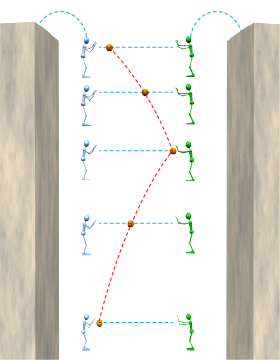|
The mass m that creates weight (F = Gmm1/R2) is the same mass that represents resistance to being accelerated in Newton’s second law (a = F/m). Why should this be so? Inertia has nothing to do with gravity! Why should an object’s resistance to acceleration be the exact same property that determines an object’s interaction with gravity? Why should it be the same “m” in both formulas? The results of every experiment tell us that the “m” is the same, but the experiments do not explain why. 
|
Einstein thought the coincidence was a clue that gravity, space, and time were connected. His theory of general relativity was published in 1915. It has been called the greatest feat of human thought ever accomplished. General relativity describes gravity in a fundamentally different way from Newton’s law of gravitation. According to Einstein, the presence of mass changes the shape of spacetime itself. In general relativity, an object in orbit is moving in a straight line through curved space! The force we call gravity is an effect created by the curvature of space and time. 
|
Imagine a boy and girl jumping into a bottomless canyon, with no air friction. As they fall, they throw a ball back and forth. The girl sees the ball go straight to the boy and vice versa. An observer at rest watching them fall, however, sees the ball follow a curved zigzag path back and forth. 
| 
|
Now, imagine the boy and girl throwing the ball but enclosed in a windowless box falling with them. From inside the box, they see the ball go straight back and forth. To them, the ball moves as if there were no gravity. Remember, gravity would cause the ball to follow a curved path. 
|
 Next, imagine the boy and girl throwing the ball back and forth in the same box but in deep space where there is no gravity. This time the box is accelerating upward. When the boy throws the ball it does not go straight but drops in a parabola toward the floor. This happens because the floor is accelerating upward and pushing the girl with it. The girl calculates the path of the ball and finds it to be exactly the same as if gravity was pulling it down.
Next, imagine the boy and girl throwing the ball back and forth in the same box but in deep space where there is no gravity. This time the box is accelerating upward. When the boy throws the ball it does not go straight but drops in a parabola toward the floor. This happens because the floor is accelerating upward and pushing the girl with it. The girl calculates the path of the ball and finds it to be exactly the same as if gravity was pulling it down. 
|
The equivalence principle says that no experiment the boy or girl can do will distinguish whether they are feeling the force of gravity or they are in a reference frame that is accelerating. Any result from any experiment is exactly the same whether the experiment is done where there is a gravitational field of 9.8 N/kg or in a reference frame that is accelerating at 9.8 m/s2. 
|

